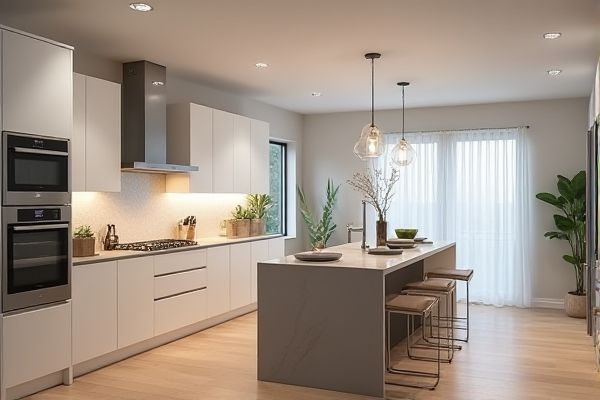
Frameless cabinets offer a sleek, modern look with easier access and more internal storage compared to traditional face-framed cabinets, which provide extra support and a classic design. Discover the key differences to decide which style best suits Your kitchen needs in the rest of this article.
Table of Comparison
| Feature | Frameless Cabinets | Face-Framed Cabinets |
|---|---|---|
| Construction | No front frame; box edges visible | Front frame attached to box edges |
| Storage Space | Maximized interior space | Reduced interior space due to frame |
| Door Style | European-style doors, flush design | Traditional doors with overlay |
| Durability | Less rigid, relies on box strength | More rigid, added frame support |
| Cost | Higher due to precise construction | Generally lower cost |
| Installation | Requires precision, less forgiving | Easier to install, frame helps alignment |
| Appearance | Sleek, modern, seamless look | Classic, traditional appearance |
| Common Usage | Modern kitchens, Europe-centric design | Traditional and custom kitchens |
Overview of Frameless and Face-Framed Cabinets
Frameless cabinets feature a full overlay design, providing a sleek and modern appearance with increased accessible storage space inside due to the absence of a front frame. Face-framed cabinets incorporate a sturdy wooden frame around the edges, enhancing durability and offering a traditional look with visible stiles and rails. The choice between frameless and face-framed cabinets impacts installation, aesthetics, and interior organization efficiency.
Key Design Differences
Frameless cabinets feature a full-access design with no face frame, providing a sleek, modern aesthetic and maximizing interior storage space. Face-framed cabinets incorporate a wooden frame around the front edges, offering added structural support and a traditional, sturdy appearance. The frame thickness typically ranges from 3/4 inch to 1 inch, influencing door overlay and hinge type options.
Construction Methods Explained
Frameless cabinets use thicker, solid panels for the cabinet box, providing a sleek, modern look with full access to the interior and minimal visible framing. Face-framed cabinets feature a front frame made of narrow wood strips attached to the cabinet box, offering added sturdiness and a traditional appearance but slightly reducing access to the cabinet interior. The choice between these construction methods affects durability, aesthetic appeal, and storage efficiency in kitchen design.
Aesthetic Appeal and Styles
Frameless cabinets offer a sleek, modern aesthetic with clean lines and a minimalist appearance, making them popular in contemporary kitchen designs. Face-framed cabinets provide a traditional and sturdy look, characterized by visible frames that add architectural detail and depth. The choice between frameless and face-framed cabinets largely depends on the desired style, where frameless suits modern, European-inspired kitchens and face-framed complements classic, rustic, or transitional interiors.
Storage Space and Accessibility
Frameless cabinets provide increased storage space with full access to the cabinet interior due to their absence of face frames, allowing for wider openings and easier retrieval of items. Face-framed cabinets use an additional frame around the cabinet box, which slightly reduces interior space and can limit access, but offers enhanced structural stability and alignment. Choosing frameless cabinets maximizes usability in smaller kitchens, while face-framed designs prioritize durability and traditional aesthetics.
Installation Processes Compared
Frameless cabinets feature a streamlined installation process, relying on full-length metal slides and adjustable fasteners, which allow for easier alignment and modification during setup. Face-framed cabinets require precise cabinet box attachment to the sturdy face frame, often needing extra time for shimming and securing each component to achieve perfect alignment. Understanding these differences can help you choose the installation method that best suits your project's complexity and your skill level.
Durability and Structural Strength
Frameless cabinets feature thicker panels and full-access construction, providing enhanced durability and structural strength compared to face-framed cabinets. The robust design of frameless cabinets supports heavier loads and resists warping over time, making them ideal for high-traffic kitchen environments. Face-framed cabinets rely on a front frame for stability but generally offer less interior space and are more prone to wear along hinges and joints.
Cost and Value Considerations
Frameless cabinets typically offer a more modern look and increased accessible storage space while often being less expensive due to simpler construction without the face frame. Face-framed cabinets provide added durability and structural stability, which can justify a higher price point and may enhance long-term value in traditional kitchen designs. Choosing between the two depends on budget priorities and desired aesthetic, with frameless cabinets appealing to cost-conscious buyers seeking maximized storage and face-framed cabinets attracting those valuing classic craftsmanship and longevity.
Popular Applications and Trends
Frameless cabinets are widely favored in modern kitchens and bathrooms due to their sleek, contemporary appearance and maximized storage space, making them ideal for minimalist and European-style designs. Face-framed cabinets remain popular in traditional and rustic settings, offering added structural support and decorative appeal with visible frames that enhance classic aesthetics. Your choice between frameless and face-framed cabinets can significantly influence the overall style and functionality of your space, reflecting current trends in home design.
Choosing the Right Cabinet Type for Your Needs
Frameless cabinets offer a modern, sleek look with full access to the interior and increased storage space, making them ideal for maximizing efficiency in compact kitchens. Face-framed cabinets provide added durability and traditional aesthetics, with a frame that reinforces the cabinet structure and supports the doors, suitable for those prioritizing strength and classic design. Understanding your kitchen layout, style preferences, and usage patterns can help you decide which cabinet type best meets your organizational needs and enhances your space.
 homyna.com
homyna.com